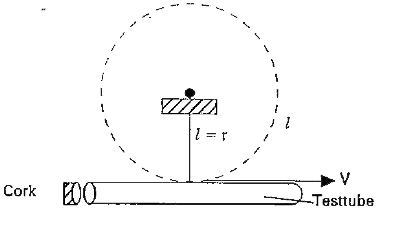A test tube of mass 10 grams closed with a cork of mass 1 gram contains some ether . When the test tube is heated the cork flies out under the pressure of the ether gas. The test tube is suspended horizontally by a weight less rigid bar of length 5 cm . What is the minimum velcoity with which the cork should fly out of the tube , so that test tube deseribing a full vertical circle about the point O . Neglect the mass of ether . Solution in Telugu
Mass of test tube M = 10g, Mass of ether
m = 1g , Length of rigid bar
= radius of circle (r) = 5 cm

∴r=5×10−2m,g=10ms2
[∴ action = - reaction ]
Given the minimum velocity of cork flies out = - v, The minimum velocity of test tube
Hence v=√5lg=√5×5×10−2×10
=5×√10−1m/s
Similar Questions
Apparatus: Big test tube, delivery tube fitted in a rubber cork, knife, candle, etc. Chemicals : Sodium metal, ethanol, magnesium ribbon, etc. Procedure : Take 10 mL ethanol in a big test tube. Cut Sodium metal into 2-3 pieces of a cereal grain size. Put the sodium pieces into the ethanol in the test tube and fix the gas delivery tube to the test tube. Take a burning candle near the outlet of the gas delivery tube and observe. Does magnesium metal react with ethanol?
04:49View SolutionA test tube of mass 10 grams closed with a cork of mass 1 gram contains some ether . When the test tube is heated the cork flies out under the pressure of the ether gas. The test tube is suspended horizontally by a weight less rigid bar of length 5 cm . What is the minimum velcoity with which the cork should fly out of the tube , so that test tube deseribing a full vertical circle about the point O . Neglect the mass of ether .
02:50View SolutionApparatus: Two test tubes, bent tube, rubber cork, burner, etc.
Chemicals: Calcium carbonate, freshly prepared lime water.
Procedure: Take some calcium carbonate in a test tube. Fit a bent tube to this test tube with the help of a rubber cork. Insert the other end of the bent tube in the freshly prepared lime water taken in the other test tube. Heat the powdered calcium carbonate in the first test tube strongly.
What will you observe?View SolutionApparatus: Big test tube, delivery tube fitted in a rubber cork, knife, candle, etc.
Chemicals : Sodium metal, ethanol, magnesium ribbon, etc.
Procedure : Take 10 mL ethanol in a big test tube. Cut Sodium metal into 2-3 pieces of a cereal grain size. Put the sodium pieces into the ethanol in the test tube and fix the gas delivery tube to the test tube. Take a burning candle near the outlet of the gas delivery tube and observe.
Does magnesium metal react with ethanol?04:49View SolutionA test tube of mass 2m closed with a cork of mass m contains a drop of liquid of negligible mass. When the test tube is heated, the liquid evaporates and the cork flies off under the pressure of the gas. What must be the minimum velocity with which the cork must be ejected such that the test tube describes a full circle of radius R about the pivot? (Assuming test tube as a point object) R 11 (2mm 5
02:41View SolutionFigure shows a cylindrical tube of radius 5cm and length 20cm. It is closed by a tight-fitting cork. The friction coefficient between the cork and the tube is 0.20. The tube contains an ideal gas at a pressure of 1atm and a temperature of 300K. The tube is slowly heated and it is found that the cork pops out when the temperature reaches 600K. Let dN denote the magnitude of the normal contact force exerted by a small length dl of the cork along the periphery (see the figure). Assuming that the temperature pf the gas is uniform at any instant, calculate(dN)/(dl).
 05:10View Solution
05:10View SolutionApparatus: Two test tubes, bent tube, rubber cork, burner, etc.
Chemicals: Calcium carbonate, freshly prepared lime water.
Procedure: Take some calcium carbonate in a test tube. Fit a bent tube to this test tube with the help of a rubber cork. Insert the other end of the bent tube in the freshly prepared lime water taken in the other test tube. Heat the powdered calcium carbonate in the first test tube strongly.
What will you observe?04:20View Solution

